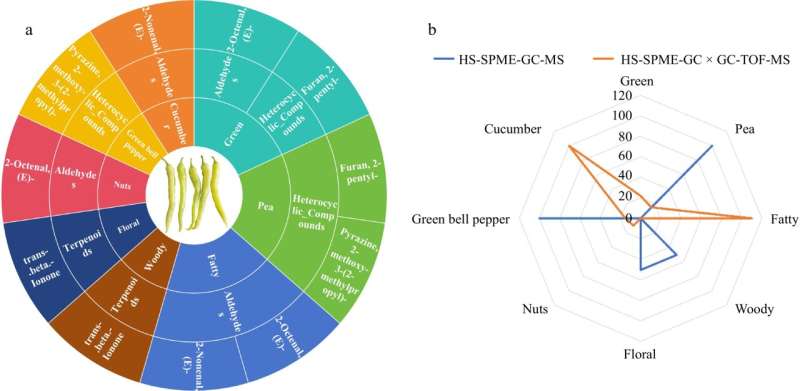This article has been reviewed according to Science X's editorial process and policies. Editors have highlighted the following attributes while ensuring the content's credibility:
fact-checked
trusted source
proofread
Unlocking the aroma secrets of Qujiao 5 chili peppers: A comprehensive VOC analysis

A research team has identified 1,558 volatile organic compounds (VOCs) in the "Qujiao 5" chili pepper cultivar var, highlighting Pyrazine, 2-methoxy-3-(2-methylpropyl)- and 2-Nonenal, (E)- as key flavor compounds in chili fruit.
This comprehensive analysis using headspace solid-phase microextraction full two-dimensional gas chromatography time of flight mass spectrometry (HS-SPME-GC × GC-TOFMS) and headspace solid-phase microextraction gas chromatography-mass spectrometry (HS-SPME-GC-MS) detection technology platforms underscore the importance of VOCs in chili flavor.
The findings offer valuable insights for enhancing chili pepper aroma and quality, laying a foundation for future breeding and cultivation of superior chili varieties.
Pepper (Capsicum annuum L.), a member of the Solanaceae family, is widely cultivated and has the highest output value in China. Beyond culinary purposes, the compounds capsaicin and capsicum exhibit substantial applications across the medical, food, and industrial sectors, providing remarkable economic and societal advantages.
The flavor composition of chili fruits is inherently intricate, arising from the intricate interplay of various sensory aspects during human consumption. Despite its nutritional richness and distinctive flavor, research on its aroma profile remains at a nascent stage. Existing studies have identified more than 300 VOCs in chili peppers, contributing to their complex aroma. However, systematic identification and analysis of key VOCs is still lacking.
A study published in Vegetable Research on 5 July 2024, detected and analyzed VOCs in chili peppers by using HS-SPME-GC-MS and HS-SPME-GC × GC-TOFMS techniques in "Qujiao 5" pepper fruits, providing essential insights for future breeding and cultivation.
In this study, HS-SPME-GC-MS analysis identified 773 VOCs, which were categorized into 15 groups, with terpenoids, esters, hydrocarbons, and heterocyclic compounds comprising more than 68% of the total. In contrast, HS-SPME-GC × GC-TOFMS identified a total of 933 VOCs, with hydrocarbons, esters, and benzene rings being predominant.
The two detection techniques collectively identified 1,558 VOCs, with 150 VOCs common to both techniques. Comparative analysis showed significant variations in VOCs' relative content as measured by the different analytical techniques, with terpenoids being the most abundant in HS-SPME-GC-MS and alcohols in HS-SPME-GC × GC-TOFMS.
Five key VOCs with relative odor activity value (ROAV) > 1 obtained from pepper fruit were identified, contributing significantly to the aroma profile of chili peppers. Sensory flavor analysis revealed primary aromatic notes like cucumber, green, pea, and fatty, while secondary aromas included fruity, sweet, and spicy notes.
According to the study's lead researcher, Yuan Cheng, "The expected results of this study are set to lay a foundational framework for further exploration into the volatile flavor compounds, sensory qualities, and metabolic regulation of horticultural crops, with a particular focus on chili peppers. Additionally, this research seeks to provide theoretical insights and practical recommendations to improve breeding, cultivation, and production practices for high-quality chili peppers."
This study utilized HS-SPME-GC-MS and HS-SPME-GC × GC-TOFMS techniques to analyze the VOCs in "Qujiao 5" chili peppers, identifying 1,558 VOCs. Key volatile flavor compounds like Pyrazine, 2-methoxy-3-(2-methylpropyl)- and 2-Nonenal, (E)- were found to significantly influence the aroma profile.
Future research will delve into the metabolic pathways and practical applications of these VOCs to enhance flavor quality and breed superior chili varieties, guiding improved breeding, cultivation, and production practices.
More information: Chenxi Ji et al, Detection and analysis of VOCs in chili pepper based on HS-SPME-GC × GC-TOFMS and HS-SPME-GC-MS techniques, Vegetable Research (2024). DOI: 10.48130/vegres-0024-0019
Provided by Chinese Academy of Sciences




















